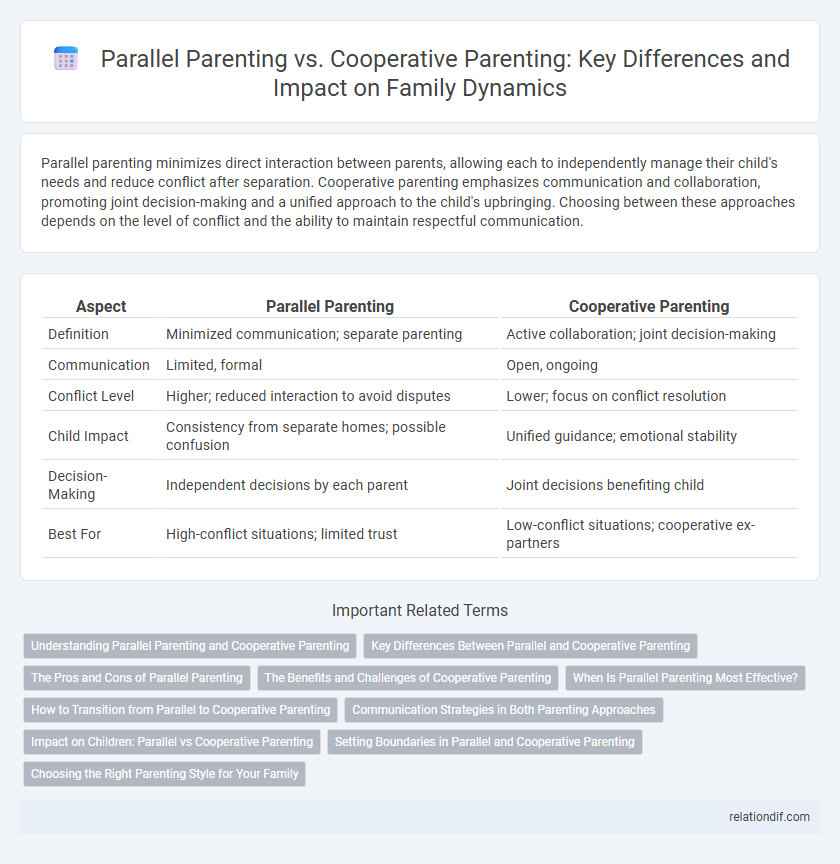Parallel parenting minimizes direct interaction between parents, allowing each to independently manage their child's needs and reduce conflict after separation. Cooperative parenting emphasizes communication and collaboration, promoting joint decision-making and a unified approach to the child's upbringing. Choosing between these approaches depends on the level of conflict and the ability to maintain respectful communication.
Table of Comparison
| Aspect | Parallel Parenting | Cooperative Parenting |
|---|---|---|
| Definition | Minimized communication; separate parenting | Active collaboration; joint decision-making |
| Communication | Limited, formal | Open, ongoing |
| Conflict Level | Higher; reduced interaction to avoid disputes | Lower; focus on conflict resolution |
| Child Impact | Consistency from separate homes; possible confusion | Unified guidance; emotional stability |
| Decision-Making | Independent decisions by each parent | Joint decisions benefiting child |
| Best For | High-conflict situations; limited trust | Low-conflict situations; cooperative ex-partners |
Understanding Parallel Parenting and Cooperative Parenting
Parallel parenting involves limited communication and strict boundaries between parents, often used after high-conflict separations to minimize interactions while ensuring consistent child care. Cooperative parenting emphasizes open communication, collaboration, and shared decision-making to create a supportive environment that prioritizes the child's well-being. Understanding these approaches helps families choose strategies that best fit their dynamics and promote effective parenting post-separation.
Key Differences Between Parallel and Cooperative Parenting
Parallel parenting minimizes direct communication between parents by allowing each to independently manage their time and responsibilities with the child, reducing potential conflict. Cooperative parenting emphasizes frequent communication, joint decision-making, and shared parenting responsibilities to provide a unified approach for the child's well-being. Key differences include the level of interaction, conflict management strategies, and the overall parenting coordination style.
The Pros and Cons of Parallel Parenting
Parallel parenting minimizes direct contact between high-conflict parents, reducing emotional triggers and enabling focus on the child's well-being. It offers clear boundaries and independence but can result in inconsistent rules and communication gaps, potentially confusing children. This approach suits contentious relationships but may limit collaborative decision-making, impacting long-term co-parenting harmony.
The Benefits and Challenges of Cooperative Parenting
Cooperative parenting fosters effective communication and consistency between parents, promoting a stable environment that benefits children's emotional development and well-being. Challenges include the need for ongoing collaboration, conflict resolution skills, and mutual respect, which can be difficult to maintain following a contentious separation. Overall, cooperative parenting supports positive co-parenting relationships by prioritizing children's needs and facilitating joint decision-making.
When Is Parallel Parenting Most Effective?
Parallel parenting is most effective in high-conflict family situations where direct communication between parents is limited or detrimental to the child's well-being. It allows each parent to maintain clear boundaries and make independent decisions while minimizing interactions that might escalate tensions. This approach supports stability and reduces stress for the child by providing structured and separate parenting roles.
How to Transition from Parallel to Cooperative Parenting
Transitioning from parallel parenting to cooperative parenting requires establishing clear communication channels and building mutual trust between parents. Implementing structured co-parenting plans with scheduled meetings to discuss the child's needs fosters collaboration and reduces conflicts. Engaging in family counseling or mediation can support emotional healing and promote a cooperative parenting mindset.
Communication Strategies in Both Parenting Approaches
Parallel parenting relies on minimal direct communication, emphasizing structured exchanges through written or digital means to minimize conflict between separated parents. Cooperative parenting encourages open, frequent dialogue and joint decision-making to foster consistency and emotional support for the child. Effective communication strategies in both approaches aim to prioritize the child's well-being while managing parental interaction based on conflict levels.
Impact on Children: Parallel vs Cooperative Parenting
Cooperative parenting fosters emotional stability and secure attachment in children by promoting consistent communication and joint decision-making between parents. Parallel parenting, characterized by limited interaction, often leads to increased stress and behavioral issues due to inconsistent discipline and emotional disconnect. Studies show children in cooperative parenting environments exhibit better social skills and academic performance compared to those in parallel parenting setups.
Setting Boundaries in Parallel and Cooperative Parenting
Setting boundaries in parallel parenting involves clear, firm limits that minimize direct communication, prioritizing individual control over interactions to reduce conflict triggers. In cooperative parenting, boundaries are more flexible and mutually agreed upon, promoting open dialogue and coordinated decision-making to support the child's needs. Both approaches emphasize consistent enforcement of rules but differ in their communication styles and level of parental collaboration.
Choosing the Right Parenting Style for Your Family
Selecting the appropriate parenting style depends on factors such as the level of communication between parents, the children's emotional needs, and the overall family dynamics. Parallel parenting minimizes conflict by limiting direct interaction and is effective in high-conflict situations, while cooperative parenting emphasizes collaboration and consistency for the child's well-being. Understanding the specific needs of your family, including the ability to maintain respectful communication, guides the decision between these approaches to support healthy child development.
parallel parenting vs cooperative parenting Infographic

 relationdif.com
relationdif.com